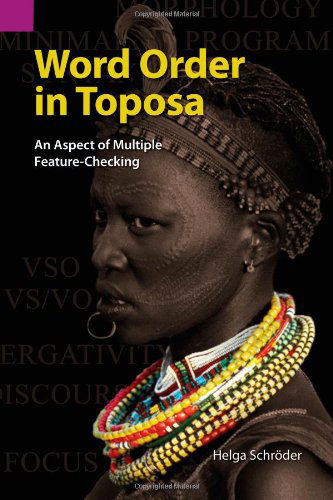
Tell your friends about this item:
Word Order in Toposa: an Aspect of Multiple Feature-checking (Sil International and the University of Texas at Arlington Publications in Linguistics, Vol. 142) First edition
Helga Schröder
Word Order in Toposa: an Aspect of Multiple Feature-checking (Sil International and the University of Texas at Arlington Publications in Linguistics, Vol. 142) First edition
Helga Schröder
This book demonstrates a feature-checking approach to sentence structure and language typology within the framework of Chomsky's Minimalist Program. The study is both data oriented and theoretical. The analysis is based on data from Toposa, an under-documented Eastern Nilotic language spoken in Southern Sudan. Toposa is highly inflectional and derivational with a basic VSO word order.
This work suggests that sentence structure is determined by multiple feature-checking processes, driven by the interaction of morphology, syntax, and discourse features such as antecedent relationships and focus. In Toposa, these interrelationships explain the occurrence or absence of the grammatical subject, direct object, and applied objects and result in an ergative VS/VO word order in discourse, where the preferred structure is to have only one argument after the verb. The complex relationships between morphology, syntax, and discourse are demonstrated through the passive, the reflexive, the subject prefixes in the verb, the causative, and the applicative.
This book will be a valuable resource for intermediate and advanced level students of syntactic theory. It should also be helpful in the further study of VSO languages and research on discourse within the framework of the Minimalist Program.
Table of Contents
Acknowledgements
Abbreviations
- Introduction
1.1 Background to the Study
1.2 Basic Language Features
1.2.1 Phonology
1.2.2 Grammar
1.3 Statement of the Problem
1.4 Objectives
1.5 Hypotheses
1.6 Rationale
1.7 Scope and Limitation
1.8 Literature Review
1.9 Research
1.10 Significance of the Study - Theoretical Framework
2.1 The Minimalist Program
2.1.1 Philosophical background
2.1.2 From lexicon to interface level
2.1.3 The morphology drive
2.1.4 The word-order parameter
2.1.5 Topic and focus
2.2 The Nominative-Accusative and Ergative-Absolutive Parameter
2.3 The Pro-Drop Parameter
2.4 Discourse Configurationality: Topic and Focus
2.5 Basic Constituent Order
2.6 The Notion of Subject
2.7 Summary and Outlook - Morphosyntactic Representations
3.1 The Basic Sentence Structure
3.2 The Nominative-Accusative Case-Marking System
3.3 Morphological Ergativity
3.3.1 Passive
3.3.2 The split cross-reference pronominal system
3.4 Argument-Changing Processes
3.4.1 Argument-increasing processes
3.4.2 Argument-decreasing processes
3.5 Applied and Direct Object
3.6 Summary - 4. Complex Verb Morphology and Word Order
4.1 Co-occurrence of Argument-Increasing Devices
4.2 Co-occurrence of Argument-Increasing and Argument-Decreasing Devices
4.2.1 Combinations with passive
4.2.2 Combinations with reflexive
4.3 Alternatives to the Double Object Construction
4.4 Summary - Complex Verb Morphology in Discourse
5.1 Principle of Reference
5.1.1 Subject and object pronouns in discourse
5.1.2 Causative and applicative in discourse
5.2 The Principle of Focus
5.2.1 Personal pronouns and focus
5.2.2 Causative/applicative and focus
5.3 Contrastive Focus
5.4 Defocalised Information
5.5 Inherent Focus
5.6 Summary - The VS/VO Ergative Word Order
6.1 The Principle of Reference in Complex Sentences
6.2 Ergative Tendencies in Complex Sentences
6.3 Argument-Reducing Processes
6.4 Syntactic Ergatives
6.5 Summary
6.6 Conclusion
Appendix A: From Lexicon to Interface
Appendix B: Nyepido
References
| Media | Books Paperback Book (Book with soft cover and glued back) |
| Released | March 1, 2008 |
| ISBN13 | 9781556711817 |
| Publishers | SIL International |
| Pages | 213 |
| Dimensions | 152 × 229 × 11 mm · 290 g |
| Language | English |
See all of Helga Schröder ( e.g. Paperback Book )

 Christmas presents can be returned until 31 January
Christmas presents can be returned until 31 January

